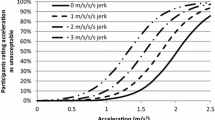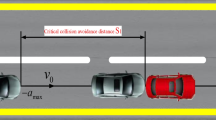Abstract
Short suspension system has an indispensable effect on vehicle handling and ride, so, optimization of vehicle suspension system is one of the most effective methods, which could considerably enhance the vehicle stability and controllability. Motion control, stability maintenance and ride comfort improvement are fundamental issues in design of suspension system of off-road vehicles. In this work, a dependent suspension system mostly used in off-road vehicles is modeled using Trucksim software. Then, geometric parameters of suspension system are optimized using integrated anti-roll bar and coiling spring in a way that ride comfort, handling and stability of vehicle are improved. The simulation results of suspension system and variations of geometric parameters due to road roughness and different steering angles are presented in Trucksim and effects of optimization of suspension system during various driving maneuvers in both optimized and un-optimized conditions are compared. The simulation results indicate that the type of suspension system and geometric parameters have significant effect on vehicle performance.
摘要
短悬架系统对车辆操纵和行驶有重要的影响, 因此优化车辆悬架系统是提高车辆稳定性和操纵性的有效方法之一。 运动控制、 稳定性维护和平顺性改善是越野车悬架系统设计中的基本问题。 基于 Trucksim 软件, 建立了一种主要应用于越野车的依赖悬架系统。 然后, 利用综合防摇杆和卷取弹簧对悬架系统的几何参数进行优化, 提高了车辆的平顺性、 操纵性和稳定性。 Trucksim 提供了悬架系统的仿真结果和由于路面粗糙度和转向角不同而引起的几何参数的变化, 并比较了在优化和非优化条件下, 悬架系统在各种驾驶操纵中的优化效果。 仿真结果表明, 悬架系统类型和几何参数对车辆性能有显著影响。
Similar content being viewed by others
References
CHEN S, WANG D, ZAN J. Vehicle ride comfort analysis and optimization using design of experiment [C]// IEEE, Intelligent Human-Machine Systems and Cybernetics (IHMSC), 2010 2nd International Conference on. Nanjing, 2010: 5–12.
UYS P E, ELS P S, THORESSON M. Suspension settings for optimal ride comfort of off-road vehicles travelling on roads with different roughness and speeds [J]. Journal of Terramechanics, 2007, 44: 163–175.
KHODAYARI B A, RAZAVI S. On the thermo-flow behavior in a rectangular channel with skewed circular ribs [J]. Mechanics & Industry, 2017, 18: 225–232.
MASHADI B, MAHMOODI-K M, KAKAEE A, HOSSEINI R. Vehicle path following control in the presence of driver inputs [J]. Proceedings of the Institution of Mechanical Engineers, Part K: Journal of Multi-body Dynamics, 2013, 227: 115–132.
MOKHIAMAR O, ABE M. Active wheel steering and yaw moment control combination to maximize stability as well as vehicle responsiveness during quick lane change for active vehicle handling safety [J]. Proceedings of the Institution of Mechanical Engineers, Part D: Journal of Automobile Engineering, 2002, 216: 115–124.
YANG X, WANG Z, PENG W. Coordinated control of AFS and DYC for vehicle handling and stability based on optimal guaranteed cost theory [J]. Vehicle System Dynamics, 2009, 47: 57–79.
POURASAD Y, MAHMOODI-K M, OVEISI M. Design of an optimal active stabilizer mechanism for enhancing vehicle rolling resistance [J]. Journal of Central South University, 2016, 23(5): 1142–1151.
TANG C Y, GUO L X. Research on suspension system based on genetic algorithm and neural network control [J]. The Open Mechanical Engineering Journal, 2009, 3: 72–79.
ALEKSANDER H. Rollover stability index including effects of suspension design [C]// SAE 2002 World Congress, Detroit, Michigan. 2002: 135–139.
KHOSRAVI M, MOSADDEGHI F, OVEISI M KHODAYARI-B A. Aerodynamic drag reduction of heavy vehicles using append devices by CFD analysis [J]. Journal of Central South University, 2015, 22: 4645–4652.
JAZAR R N. Vehicle dynamics theory and application [M]. Springer Science & Business Media, LLC, 2008: 234–288.
JANSEN S, OOSTEN J. Development and evaluation of vehicle simulation models for a 4WS application [J]. Vehicle System Dynamics, 1995, 24: 343–363.
SHIM T, VELUSAMY P C. Suspension design and dynamic analysis of a lightweight vehicle [J]. Int Journal of Vehicle Design, 2007, 43: 258–280.
ZAIDIE M N A, HASHIM M S M, TASYRIF M, BASHA M H, IBRAHIM I, KAMARUDDIN N S, SHAHRIMAN A B. Analysis of a front suspension system for UniART FSAE car using FEA [J]. Journal of Physics: Conference Series, 2017, 908(1): 120–129.
DIXON J C. Suspension geometry and computation [M]. John Wiley & Sons Ltd, 2009.
MONTAZERI-GH M, MAHMOODI-K M. Optimized predictive energy management of plug-in hybrid electric vehicle based on traffic condition [J]. Journal of Cleaner Production, 2016, 139: 935–948.
MOKHLESPOUR I, MOSAYEBI M, POURSHAMS M. Optimization of double wishbone suspension system with variable camber angle by hydraulic mechanism [J]. World Academy of Science, Engineering and Technology, 2010, 4: 46–61.
Author information
Authors and Affiliations
Corresponding author
Rights and permissions
About this article
Cite this article
Javanshir, I., Maseleno, A., Tasoujian, S. et al. Optimization of suspension system of heavy off-road vehicle for stability enhancement using integrated anti-roll bar and coiling spring mechanism. J. Cent. South Univ. 25, 2289–2298 (2018). https://doi.org/10.1007/s11771-018-3913-6
Received:
Accepted:
Published:
Issue Date:
DOI: https://doi.org/10.1007/s11771-018-3913-6




